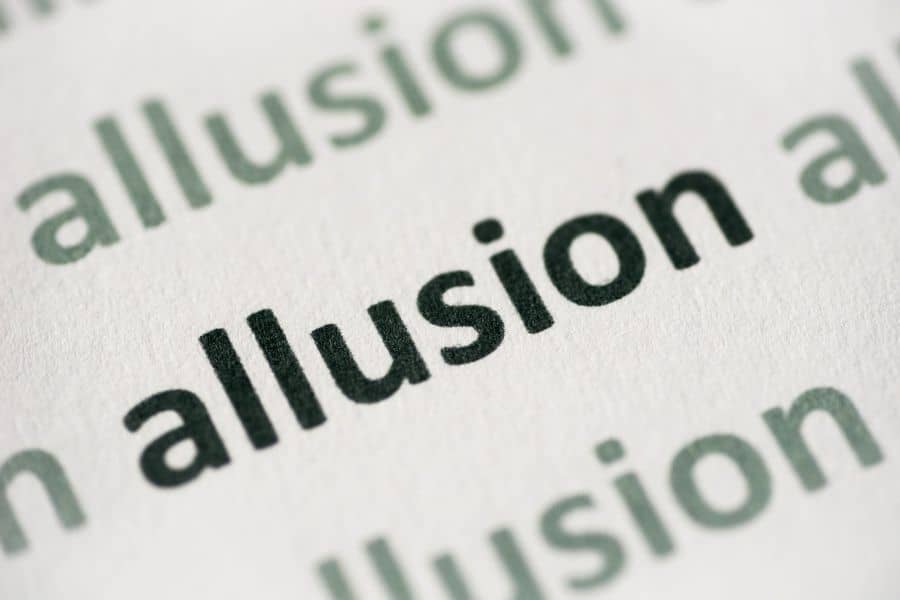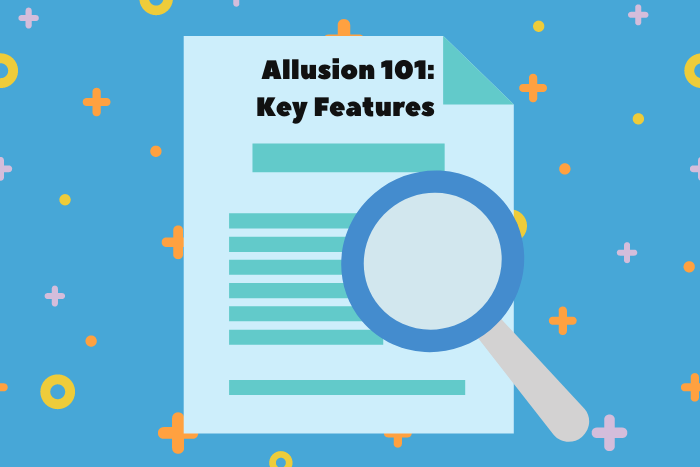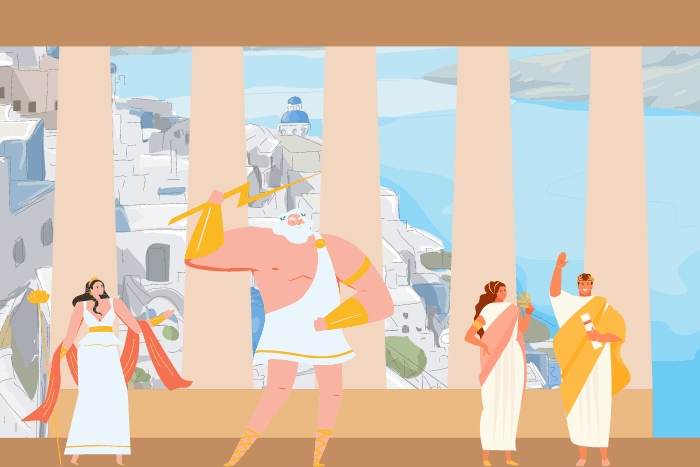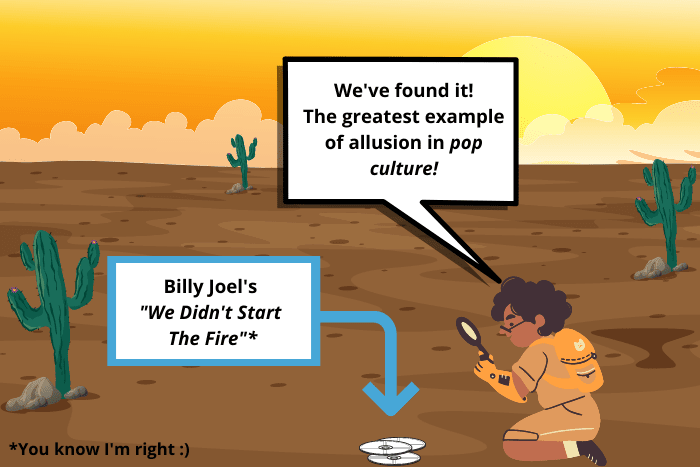If you’re a writer like me, you want to weave these references into your story, article, screenplay, speech, or conversation — giving your audience that spark of recognition.
So what are some good allusions you can use to draw readers in?
In this post, I’ll define allusion, give you over 25 examples of allusions, and then I’ll show you how to use them effectively in your writing.
Let’s dive in!

What is Allusion?
Put simply, an allusion refers to something outside the moment in which your scene, song, or statement takes place.
An external allusion (which most allusions are) refers to something outside your story but familiar to your reader.
An internal allusion refers to something earlier in your story, which you hope your reader noticed.
TLDR; an allusion is like a subtle reference to something.
Understanding Allusions
It helps to have a working allusion definition.
But to really understand allusions, you need to see them in context and get a handle on some of their history as a literary device.
Storytellers use allusions all the time and have for centuries. If they can trigger a memory in their reader, they can draw them more deeply into the scene.
The reader picks up the allusion, recognizes the reference, and feels more like an insider — someone with shared knowledge.
Plus, any mental images that come to mind due to the allusion help tie the story to the reader’s own experience.
As common as they are, it’s important to distinguish between allusions and other literary devices like the following:
- Allegory: when a character symbolizes a real-world problem, value, or occurrence
- Analogy: when two unrelated objects are compared to show similarities
- Archetype: a universal idea, symbol, pattern, or character type used in a story
- Citation: directly referencing a relevant author or source by name
- Foreshadowing: an indirect reference to something that will happen later
- Parody: imitating an author or style with intent to ridicule
- Pastiche: imitating an author or style with intent to celebrate
- Satire: uses humor, irony, or exaggeration to criticize, mock, or poke fun at a target (often a politician)
How to Recognize Allusions

To recognize an allusion and distinguish it from similar literary terms, keep the following in mind (especially with external allusions):
- Allusions refer to something the author’s peers/audience will likely know about
- Unlike foreshadowing, allusion refers to something that’s already happened
- Unlike with archetypes, the thing alluded to is not universally known or timeless
- The passage of time can make allusions less effective; familiarity is not guaranteed
- Allusions do not require nor offer further explanation
Authors use allusion with the assumption that most if not all their readers are familiar with what they’re referencing.
And in some cases — like allusions to bible stories or to Roman or Greek mythology — the references retain their potency over the years.
Not all allusions age well.
But the examples below reference events, stories, and characters that still have a prominent place in our collective memory.
25 Allusion Examples That’ll Add Layers to Your Writing
We’ve grouped the following collection of allusion examples according to type. Depending on your background and interests, some are likely to be more familiar than others.
Allusions in Classical Mythology

Allusions to Greek and Roman mythology have aged fairly well over the centuries. Allude to a Greek or Roman god or myth and those who share that knowledge pay closer attention.
Ask yourself if any of the following common examples sound familiar.
- “He’s hosting his annual Bacchanal this weekend. Most of the neighborhood is showing up. The rest have the cops on speed dial.”
The allusion to Bacchus / Dionysus — the god of wine and revelry — lets the reader (and the neighbors) know what to expect of the party being held.
- Midas Tire Company’s motto: “Trust the Midas touch.”
The motto alludes to the mythological King Midas whose touch could turn anything (or anyone) to gold. Midas Tire Company uses that allusion to convey the idea that whatever project they touch will “turn to gold,” i.e., result in the best outcome for their customers.
- “The mayor’s protean policies mirrored those of his most generous supporters.”
Here, the speaker alludes to the Greek god Proteus, who could change his shape at will. Another mythological figure used in a similar way is the two-faced Roman god Janus.
Biblical Allusions
The bible is actually the source of numerous allusions we use in everyday speech.
Here are some of the more familiar ones you’ve probably heard (or used yourself):
- “There he goes again, playing the Good Samaritan.”
This allusion references the popular Bible story to describe someone who goes out of their way to help a stranger.
- “I guess that’s just my cross to bear.”
This biblical allusion references the crucifixion of Jesus and meaning a burden to bear or suffering to accept or tolerate.
- “Your father has the patience of Job!”
And finally, this reference alluding the biblical character, Job, to describe someone with extreme patience in the face of unusual challenges.
Allusion Examples in Poetry

Allusions in poetry can either be brief references or extended parallels that continue throughout the piece — or for a significant part of it.
- “Nothing Gold Can Stay” (1923) by Robert Frost
“Then leaf subsides to leaf.
So Eden sank to grief,
So dawn goes down to day.
Nothing gold can stay.”
Frost briefly references the Garden of Eden in the bible to drive home his point that not even paradise can last forever.
- All Overgrown By Cunning Moss” by Emily Dickinson
“All overgrown by cunning moss,
All interspersed with weed,
The little cage of “Currer Bell“
In quiet “Haworth” laid.”
Currer Bell was the pen name of Charlotte Bronte, who died and was buried in the English village of Haworth. Dickinson wrote this poem as a tribute to Bronte on the fourth anniversary of her death.
- “Poem Written in a Copy of Beowulf” by Jorge Luis Borges
”At various times, I have asked myself what reasons
moved me to study, while my night came down,
without particular hope of satisfaction,
the language of the blunt-tongued Anglo-Saxons.”
The entire poem depends on its audience’s familiarity with the story of Beowulf — its origins and its significance to world literature.
- “A Name” by Ada Limón
‘When Eve walked among
the animals and named them—
nightingale, red-shouldered hawk,
fiddler crab, fallow deer—
I wonder if she ever wanted
them to speak back, looked into
their wide wonderful eyes and
whispered, ‘Name me, name me.’”
The allusion to Eve from the book of Genesis isn’t meant to be biblically accurate; the point is to take a well-known character and ask “What if…”?
Historical Allusion Examples
History is full of interesting characters, some more notorious than others. Each example highlights just a sampling of figures and events that still capture our attention.
- To Kill a Mockingbird (1960) by Harper Lee
“Are we poor, Atticus?”
Atticus nodded. “We are indeed.”
Jem’s nose wrinkled. “Are we as poor as the Cunninghams?”
“Not exactly. The Cunninghams are country folks, farmers, and the crash hit them hardest.”
When the character Atticus Finch mentions “the crash,” he’s alluding to the Stock Market Crash of 1929, which led to the Great Depression.
- Star Trek (original series) allusions to Cold War events.
The creator, Gene Roddenberry, wanted to create episodes that alluded to the most pressing social and political controversies of the 1960s — the nuclear arms race, the Vietnam War, sexual liberation, and race relations.
- Moby Dick (1851) by Herman Melville
The 19th-century whaling ship in the story is named Pequod, which alludes to the Native American Pequot tribe. Melville’s original audience was likely familiar with the Pequot War of 1636-1637, which nearly drove this tribe to extinction.
In this case, the ship’s name was both an allusion and a foreshadowing.
Examples of Allusion in Literature

Allusions in literature typically reference classic literary work, mythological or religious characters, or historical characters and events.
Consider the following literary allusion examples:
- William Shakespeare’s Hamlet
“See what a grace was seated on this brow,
Hyperion‘s curls, the front of Jove himself,
An eye like Mars‘ to threaten and command …”
William Shakespeare uses mythological allusions to show Hamlet’s admiration for his murdered father — comparing the latter to three gods in Roman mythology.
- Heart of Darkness by Joseph Conrad
“The two knitting women increase his anxiety by gazing at him and all the other sailors with knowing unconcern.
Their eerie looks suggest that they know what will happen (the men dying), yet don’t care.”
Before this quote, Conrad describes the knitting women as “guarding the door of darkness,” alluding to the Fates of Greek mythology, who spin, measure, and cut the threads of life.
- Look Back In Anger (1957 play) by John Osborne
“I suppose people of our generation aren’t able to die for good causes any longer.
We had all that done for us, in the thirties and forties, when we were still kids.
There aren’t any good, brave causes left.
If the big bang does come, and we all get killed off, it won’t be in aid of the old-fashioned grand design.
It’ll just be for the Brave New-nothing-very-much-thank-you.”
While he never explicitly references the Second World War, Osborne clearly alludes to it here when explaining his generation’s relative lack of purpose.
Allusion Examples in Film & Television
It’s not hard to find common examples of allusion in both film and television series, as you’ll see from the few listed below.
- Ferris Bueller’s Day Off (1986)
When Cameron leaves his father’s Ferrari at a Chicago parking garage, he doesn’t see the valet taking it for a joyride and soaring down the road to the tune of the Star Wars theme, off on an adventure of his own.
- Clueless (1995)
The teen comedy is essentially a modern retelling of the 1815 novel, Emma, by Jane Austen, though even viewers unfamiliar with the original could enjoy the film on its own.
- The Angel series (1999 to 2004)
In one episode, Angel (played by David Boreanaz) describes a painting by Manet that features the French poet and critic Baudelaire:
“Now, Baudelaire… interesting fellow. In his poem ‘Le Vampyre’ he wrote: ‘Thou who abruptly as a knife didst come into my heart.’ He, ah, strongly believed that evil forces surrounded mankind. And some even speculated that the poem was about a real vampire. (He laughs). Oh and, ah, Baudelaire’s actually a little taller and a lot drunker than he’s depicted here.”
Allusions in Popular Culture

Pop culture allusions come in different types:
- Allusions in pop culture that reference other pop culture
- Allusions in pop culture that reference something other than pop culture
- Allusions in everyday speech, marketing, or entertainment that reference pop culture
- Doctor Who, Season 2: Episode #12: “Army of Ghosts”
In this episode, the Doctor (played by David Tennant), says, “Who you gonna call?” and his companion, Rose Tyler, replies with “Ghostbusters!” alluding to the trademark phrase from the well-known movie franchise (as well as the song).
- Taylor Swift’s “Love Story”
“…That you were Romeo, you were throwing pebbles
and my daddy said ‘Stay away from Juliet‘…”
The song alludes to the lead characters in Shakespeare’s Romeo and Juliet. Romeo snuck into the garden outside Juliet’s window, throwing pebbles to get her attention.
- Kraft Mac’N’Cheese commercial with rapper Vanilla Ice
Not only did Kraft sell their product using a rapper familiar to the age group most likely to be buying it; the commercial also promoted Kraft’s new Ninja Turtle-shaped pasta, reminding viewers of the role Vanilla Ice had played in a Turtles movie.
- Billy Joel’s “We Didn’t Start the Fire”
If you’ve never heard this song before, give it a listen. Almost every word is a direct allusion to a major historical event in the 20th century.
Let’s take a look at the last verse before the outro:
“Wheel of Fortune, Sally Ride, heavy metal suicide
Foreign debts, homeless vets, AIDS, crack, Bernie Goetz
Hypodermics on the shore, China’s under martial law
Rock and roller, cola wars, I can’t take it anymore”
See what I mean?
Allusions in Everyday Speech
You’ve probably heard some variation on each example:
- “Wow, Einstein… Thanks for the tip.”
Using sarcasm + an allusion to Albert Einstein, a historical figure recognized as a genius.
- “Cupid’s arrows only work if you have a heart.”
A mythological allusion to the Roman god Cupid.
- “You don’t have to carry the weight of the world on your shoulders.”
Alluding to the Greek god Atlas
You can probably think of others. We’re constantly connecting things and using those connections in our conversations and writings to draw people together.
How to Use Allusion in Your Writing
You have some idea, now, of why you’d like to use allusions in your work:
- To create a sense of kinship with your readers
- To convey a complex idea or connect your story to them
- To add layers to your story and its characters
- To engage with works your readers are already familiar with
- To demonstrate your cultural literacy or challenge that of your readers
But maybe you’re not yet sure just how to use them in your own writing. Here are a few time-tested ideas to get you started:
- Create a character reminiscent of a well-known character or archetype.
- Create a story similar to a beloved classic — but with a modern twist.
- Reference a well-known work for the purpose of contrasting it with yours.
- Use multiple allusions of a particular kind to hold your reader’s interest.
- Practice using allusions as creative writing prompts.
The more you allude to well-known works, events, and characters, the easier it is to connect with your target audience, build trust, and establish yourself as an authority.
Make the best use of this timeless literary technique, and your writing will live rent-free in the minds of your readers.
And the more powerful your writing portfolio becomes, the more people you’ll reach with your dazzling words.
What’s Your Biggest Takeaway From These Allusion Examples?
Now that you’ve looked through all 26 examples of allusions, which types would you like to explore or use more often?
Which holds particular appeal for you when you catch them in other people’s work?
As you’ve seen from the allusion examples listed above, all kinds of writers — including copywriters, bloggers, poets, and storytellers — use allusions to get their readers’ attention and stand out from the competition.
Now, it’s your turn to practice. Use the examples as prompts to get your mind working on allusion ideas of your own.
If you’re having fun with it, you’re doing something right.




